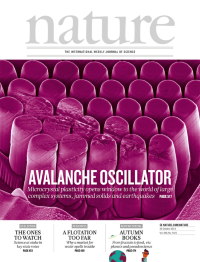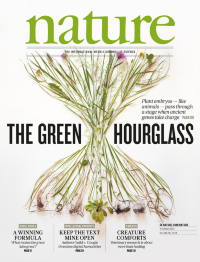Volume 490
-
No. 7421 25 October 2012
Many systems respond impulsively to slowly increasing external stresses. Normally smooth processes of stress release can be disrupted intermittently by large random events (or avalanches), such that a system undergoes abrupt structural changes. Using a combination of theory and experiment in a model system consisting of nickel microcrystals under compression, Stefanos Papanikolaou and colleagues investigate an intermediate regime in which the smooth background processes occur at similar rates to the external driving stresses, leading to the unusual observation of themselves. This finding is, in principle, applicable to all intermittent phenomena with coexisting slow relaxations that compete to minimize the local internal stress. This description would include complex networks � such as the brain � during relaxation, disordered/jammed solids and earthquake faults, forcing a re-interpretation of experimental and simulation data. The cover shows a nickel microcrystal array with an overlay outline of the San Andreas Fault, where the forces observed in the microcrystals act on a larger scale. (Array by Dennis M. Dimiduk/ fault by D K Lynch/ USGS)
-
No. 7420 18 October 2012
A succession of superpowers once dominated the world of science: France, Germany, the United Kingdom and the United States have all had their moments. Today, many countries prominently China, Brazil and South Korea have an important place in the research hierarchy. Researchers are much more mobile than in the past and can follow funding and facilities around the world, and the development of supranational collaboration networks is changing the role of national governments and funding agencies. This special issue of Nature looks at how the movement of people and ideas is changing how and where science is done, how it is funded and where current trends will lead. Cover: Jasiek Krzysztofiak/Nature.
-
No. 7419 11 October 2012
Some individuals can cope with stress � from the extremes of battle to the pressures of modern life � with no apparent ill effects. Others in similar situations will develop serious mental illness. The efforts of neuroscientists to track down the elusive links between life experience and mental illness are the focus of in this weeks Nature. Cover: Paddy Mills
Nature Outlook
-
No. 7418 4 October 2012
As it develops from a single-celled zygote to a mature plant embryo, the thale cress Arabidopsis thalianapasses through a stage during which phylogenetically very ancient genes are preferentially expressed. This corroborates recent work on animals demonstrating a similar period of embryogenesis that coincides with what nineteenth-century zoologists recognized as a phase in development — at least in vertebrates — in which embryos of all species looked very similar. It seems that animals and plants have independently converged on a similar way of managing gene expression as they transform from a single-celled zygote to a multicellular organism, even though their morphological development is very different. Cover art by www.sistersofdesign.de




